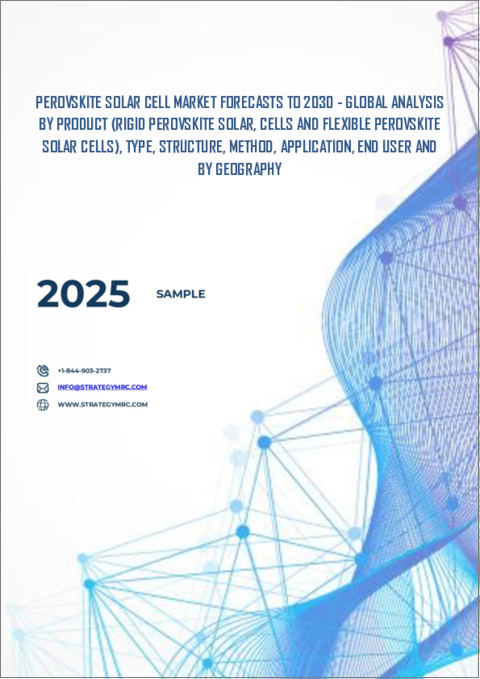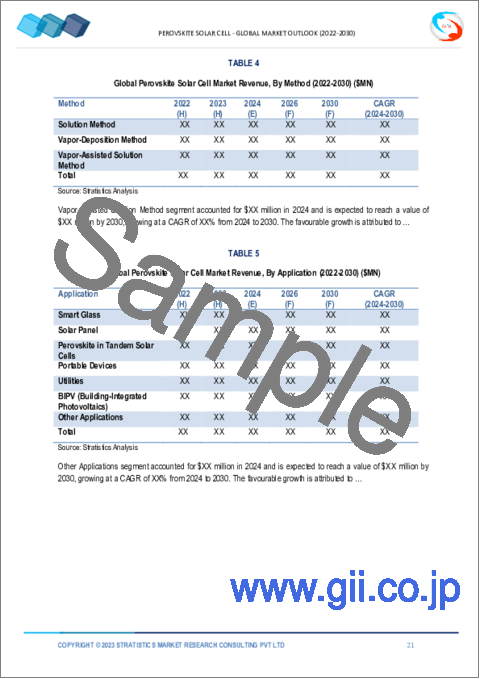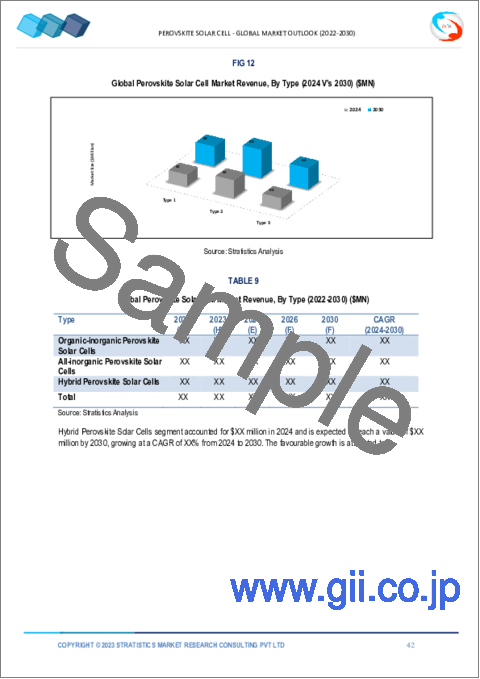|
|
市場調査レポート
商品コード
1569866
ペロブスカイト太陽電池市場の2030年までの予測: 製品別、タイプ別、構造別、方式別、用途別、エンドユーザー別、地域別の世界分析Perovskite Solar Cell Market Forecasts to 2030 - Global Analysis By Product (Rigid Perovskite Solar, Cells and Flexible Perovskite Solar Cells), Type, Structure, Method, Application, End User and By Geography |
||||||
カスタマイズ可能
|
|||||||
| ペロブスカイト太陽電池市場の2030年までの予測: 製品別、タイプ別、構造別、方式別、用途別、エンドユーザー別、地域別の世界分析 |
|
出版日: 2024年10月10日
発行: Stratistics Market Research Consulting
ページ情報: 英文 200+ Pages
納期: 2~3営業日
|
- 全表示
- 概要
- 図表
- 目次
Stratistics MRCによると、世界のペロブスカイト太陽電池市場は、2024年に9,230万米ドルとなり、予測期間中に44.21%のCAGRで成長し、2030年までには8億3,070万米ドルに達すると予測されています。
ペロブスカイト太陽電池は、ペロブスカイト構造化合物を光吸収層として利用する光起電力技術の一種です。鉱物のペロブスカイト(酸化チタンカルシウム)にちなんで名付けられたこの太陽電池は、その驚くべき効率と製造の容易さで知られています。通常、有機-無機ハイブリッド材料で構成されるペロブスカイト太陽電池は、軽量で柔軟性がありながら、高い電力変換効率を達成することができます。
技術の進歩
材料と製造プロセスにおける革新は、セルの性能と耐久性を向上させ、従来のシリコン・セルとの競争力を高めています。タンデム構成や優れたカプセル化技術などの画期的な進歩により、様々な分野での応用が拡大しています。このような進歩は投資と研究の増加を促し、急速な商業化を促進し、ペロブスカイト技術を再生可能エネルギーの主要プレーヤーとして位置づけ、最終的には持続可能なエネルギーソリューションへの移行を加速させ、市場の成長を牽引しています。
安定性と耐久性の問題
安定性と耐久性の問題とは、ペロブスカイト太陽電池が湿気、熱、紫外線などの環境要因の影響を受けやすく、時間の経過とともに性能が低下する可能性があることです。これらの課題は、セルの商業的な実現可能性と長期的な信頼性を制限することで、市場に影響を与えます。その結果、寿命や性能に関する懸念が投資家の信頼を妨げ、再生可能エネルギー分野での採用が遅れます。そのため、市場の成長を阻害しています。
政府の支援
政府の支援は、研究開発を奨励する資金、インセンティブ、規制の枠組みを提供することで、市場を発展させる上で極めて重要です。多くの国が気候変動目標を達成するために再生可能エネルギー技術を優先しており、これが技術革新を促進し、商業化を加速させています。クリーン・エネルギー・プロジェクトに対する助成金や補助金は、メーカーや研究者の財政的障壁を下げ、官民の協力を強化します。その結果、市場の成長が促進されます。
規制上の課題
規制上の課題には、新技術の複雑な承認プロセスを乗り越えることが含まれ、ペロブスカイト太陽電池の市場参入を遅らせる可能性があります。特に鉛の使用に関する厳しい安全基準や環境基準は、商業化への取り組みを複雑にしています。こうした障害は、技術革新を遅らせ、投資を減らし、普及を妨げ、最終的には再生可能エネルギー市場におけるペロブスカイト技術の成長可能性を制限し、市場の成長を妨げることになります。
COVID-19の影響:
COVID-19の大流行は、サプライチェーンの中断や研究開発プロジェクトの停止を引き起こし、ペロブスカイト太陽電池市場を混乱させました。しかし、パンデミック後は政府が持続可能性を優先したため、再生可能エネルギーへのシフトが加速しました。このような新たな焦点は、ペロブスカイト技術への投資と技術革新を促進し、クリーンエネルギー・ソリューションの需要が高まるにつれて、ペロブスカイト技術の成長を位置づけています。
予測期間中、航空宇宙分野が最大になる見込み
ペロブスカイト電池は高効率であるため、宇宙用途に最適です。これらのセルは、人工衛星やその他の航空宇宙技術の発電を強化し、運用寿命の延長や打ち上げコストの削減に貢献します。過酷な環境下での安定性と性能に関する継続的な研究が、さらに関心を高めています。ペロブスカイト太陽電池の統合は拡大し、宇宙開発における革新と効率を促進する態勢が整っています。
スマートガラス分野は予測期間中最も高いCAGRが見込まれる
スマートガラス分野は、建築材料への高度なエネルギー捕集機能により、予測期間中に最も高いCAGRが見込まれます。この技術により、窓は光と熱を管理しながら発電し、建物のエネルギー効率を高めることができます。スマートガラスとペロブスカイト太陽電池の組み合わせは、その軽量で柔軟な性質を生かし、建築や都市設計への革新的な応用を促進します。スマートガラスとペロブスカイト太陽電池の相乗効果が市場の成長を促進し、よりスマートなエネルギーソリューションへの道を開きます。
最大のシェアを占める地域:
北米は、効率的で費用対効果の高い再生可能エネルギ・ソリューションに対する需要の増加により、予測期間中最大の市場シェアを占めると予測されています。特に米国とカナダでは、技術の進歩と継続的な研究イニシアチブが技術革新と商業化を促進しています。ペロブスカイト太陽電池は、従来の太陽電池技術に比べて高い効率と汎用性が約束されているため、政府の奨励策や環境規制がさらに採用を後押ししています。
CAGRが最も高い地域:
アジア太平洋は、再生可能エネルギーに対する需要の高まりと、持続可能な技術に対する政府の優遇措置により、予測期間中に最も高いCAGRを示すと予測されています。ペロブスカイト太陽電池は、従来の太陽電池に比べて製造コストが低く、効率が高いなどの利点があるため、多額の投資と研究が行われています。この成長は、エネルギー安全保障を後押しするだけでなく、気候変動と闘う地域の取り組みにも貢献しています。
無料カスタマイズサービス:
本レポートをご購読のお客様には、以下の無料カスタマイズオプションのいずれかをご利用いただけます:
- 企業プロファイル
- 追加市場プレイヤーの包括的プロファイリング(3社まで)
- 主要企業のSWOT分析(3社まで)
- 地域セグメンテーション
- 顧客の関心に応じた主要国の市場推計・予測・CAGR(注:フィージビリティチェックによる)
- 競合ベンチマーキング
- 製品ポートフォリオ、地理的プレゼンス、戦略的提携に基づく主要企業のベンチマーキング
目次
第1章 エグゼクティブサマリー
第2章 序文
- 概要
- ステークホルダー
- 調査範囲
- 調査手法
- データマイニング
- データ分析
- データ検証
- 調査アプローチ
- 調査情報源
- 1次調査情報源
- 2次調査情報源
- 前提条件
第3章 市場動向分析
- 促進要因
- 抑制要因
- 機会
- 脅威
- 製品分析
- 用途分析
- エンドユーザー分析
- 新興市場
- COVID-19の影響
第4章 ポーターのファイブフォース分析
- 供給企業の交渉力
- 買い手の交渉力
- 代替品の脅威
- 新規参入業者の脅威
- 競争企業間の敵対関係
第5章 世界のペロブスカイト太陽電池市場:製品別
- リジッドペロブスカイト太陽電池
- フレキシブルペロブスカイト太陽電池
第6章 世界のペロブスカイト太陽電池市場:タイプ別
- 有機-無機ペロブスカイト太陽電池
- 全無機ペロブスカイト太陽電池
- ハイブリッドペロブスカイト太陽電池
第7章 世界のペロブスカイト太陽電池市場:構造別
- 平面ペロブスカイト太陽電池
- メソポーラスペロブスカイト太陽電池
第8章 世界のペロブスカイト太陽電池市場:方式別
- 溶液法
- 蒸着法
- 蒸気アシスト溶液法
第9章 世界のペロブスカイト太陽電池市場:用途別
- スマートグラス
- ソーラーパネル
- タンデム太陽電池のペロブスカイト
- ポータブルデバイス
- ユーティリティ
- BIPV(建物一体型太陽光発電)
- その他の用途
第10章 世界のペロブスカイト太陽電池市場:エンドユーザー別
- 製造業
- エネルギー
- 産業オートメーション
- 航空宇宙
- コンシューマーエレクトロニクス
- その他のエンドユーザー
第11章 世界のペロブスカイト太陽電池市場:地域別
- 北米
- 米国
- カナダ
- メキシコ
- 欧州
- ドイツ
- 英国
- イタリア
- フランス
- スペイン
- その他欧州
- アジア太平洋
- 日本
- 中国
- インド
- オーストラリア
- ニュージーランド
- 韓国
- その他アジア太平洋
- 南米
- アルゼンチン
- ブラジル
- チリ
- その他南米
- 中東・アフリカ
- サウジアラビア
- アラブ首長国連邦
- カタール
- 南アフリカ
- その他中東・アフリカ
第12章 主要な発展
- 契約、パートナーシップ、コラボレーション、合弁事業
- 買収と合併
- 新製品発売
- 事業拡大
- その他の主要戦略
第13章 企業プロファイリング
- 8minutenergy Renewables
- Canadian Solar
- Enel Green Power
- First Solar
- GCell
- Hanwha Q CELLS
- Heliatek
- JinkoSolar
- Kalyon Solar Technologies
- LONGi Solar
- Microquanta Semiconductor
- Oxford PV
- Perovskite Solar Cells(PSCs)
- Siva Power
- Solar Frontier
- Solaronix
- SolarWorld
- Swift Solar
- Trina Solar
List of Tables
- Table 1 Global Perovskite Solar Cell Market Outlook, By Region (2022-2030) ($MN)
- Table 2 Global Perovskite Solar Cell Market Outlook, By Product (2022-2030) ($MN)
- Table 3 Global Perovskite Solar Cell Market Outlook, By Rigid Perovskite Solar Cells (2022-2030) ($MN)
- Table 4 Global Perovskite Solar Cell Market Outlook, By Flexible Perovskite Solar Cells (2022-2030) ($MN)
- Table 5 Global Perovskite Solar Cell Market Outlook, By Type (2022-2030) ($MN)
- Table 6 Global Perovskite Solar Cell Market Outlook, By Organic-inorganic Perovskite Solar Cells (2022-2030) ($MN)
- Table 7 Global Perovskite Solar Cell Market Outlook, By All-inorganic Perovskite Solar Cells (2022-2030) ($MN)
- Table 8 Global Perovskite Solar Cell Market Outlook, By Hybrid Perovskite Solar Cells (2022-2030) ($MN)
- Table 9 Global Perovskite Solar Cell Market Outlook, By Structure (2022-2030) ($MN)
- Table 10 Global Perovskite Solar Cell Market Outlook, By Planar Perovskite Solar Cells (2022-2030) ($MN)
- Table 11 Global Perovskite Solar Cell Market Outlook, By Mesoporous Perovskite Solar Cells (2022-2030) ($MN)
- Table 12 Global Perovskite Solar Cell Market Outlook, By Method (2022-2030) ($MN)
- Table 13 Global Perovskite Solar Cell Market Outlook, By Solution Method (2022-2030) ($MN)
- Table 14 Global Perovskite Solar Cell Market Outlook, By Vapor-Deposition Method (2022-2030) ($MN)
- Table 15 Global Perovskite Solar Cell Market Outlook, By Vapor-Assisted Solution Method (2022-2030) ($MN)
- Table 16 Global Perovskite Solar Cell Market Outlook, By Application (2022-2030) ($MN)
- Table 17 Global Perovskite Solar Cell Market Outlook, By Smart Glass (2022-2030) ($MN)
- Table 18 Global Perovskite Solar Cell Market Outlook, By Solar Panel (2022-2030) ($MN)
- Table 19 Global Perovskite Solar Cell Market Outlook, By Perovskite in Tandem Solar Cells (2022-2030) ($MN)
- Table 20 Global Perovskite Solar Cell Market Outlook, By Portable Devices (2022-2030) ($MN)
- Table 21 Global Perovskite Solar Cell Market Outlook, By Utilities (2022-2030) ($MN)
- Table 22 Global Perovskite Solar Cell Market Outlook, By BIPV (Building-Integrated Photovoltaics) (2022-2030) ($MN)
- Table 23 Global Perovskite Solar Cell Market Outlook, By Other Applications (2022-2030) ($MN)
- Table 24 Global Perovskite Solar Cell Market Outlook, By End Users (2022-2030) ($MN)
- Table 25 Global Perovskite Solar Cell Market Outlook, By Manufacturing (2022-2030) ($MN)
- Table 26 Global Perovskite Solar Cell Market Outlook, By Energy (2022-2030) ($MN)
- Table 27 Global Perovskite Solar Cell Market Outlook, By Industrial Automation (2022-2030) ($MN)
- Table 28 Global Perovskite Solar Cell Market Outlook, By Aerospace (2022-2030) ($MN)
- Table 29 Global Perovskite Solar Cell Market Outlook, By Consumer Electronics (2022-2030) ($MN)
- Table 30 Global Perovskite Solar Cell Market Outlook, By Other End Users (2022-2030) ($MN)
Note: Tables for North America, Europe, APAC, South America, and Middle East & Africa Regions are also represented in the same manner as above.
According to Stratistics MRC, the Global Perovskite Solar Cell Market is accounted for $92.3 million in 2024 and is expected to reach $830.7 million by 2030 growing at a CAGR of 44.21% during the forecast period. Perovskite solar cells are a type of photovoltaic technology that utilizes perovskite-structured compounds as the light-absorbing layer. Named after the mineral perovskite (calcium titanium oxide), these cells are known for their remarkable efficiency and ease of fabrication. Typically composed of organic-inorganic hybrid materials, perovskite solar cells can achieve high power conversion efficiencies while being lightweight and flexible.
Market Dynamics:
Driver:
Technological Advancements
Innovations in materials and manufacturing processes enhance cell performance and durability, making them more competitive with traditional silicon cells. Breakthroughs such as tandem configurations and better encapsulation techniques are expanding applications in various sectors. These advancements attract increased investment and research, fostering rapid commercialization and positioning perovskite technology as a key player in the renewable energy landscape, ultimately accelerating the transition to sustainable energy solutions, thus it drives the growth of the market.
Restraint:
Stability and Durability Issues
Stability and durability issues is the susceptibility of perovskite solar cells to environmental factors like moisture, heat, and UV light, which can degrade their performance over time. These challenges impact the market by limiting the cells' commercial viability and long-term reliability. Consequently, concerns about lifespan and performance hinder investor confidence and slow adoption in the renewable energy sector. Thus, it hinders the growth of the market.
Opportunity:
Government Support
Government support is pivotal in advancing the market by providing funding, incentives, and regulatory frameworks that encourage research and development. Many countries are prioritizing renewable energy technologies to meet a climate goal, which fosters innovation and accelerates commercialization. Grants and subsidies for clean energy projects lower financial barriers for manufacturers and researchers, enhancing collaboration between public and private sectors. Thus, it boosts the growth of the market.
Threat:
Regulatory Challenges
Regulatory challenges involve navigating complex approval processes for new technologies, which can delay the market entry of perovskite solar cells. Stringent safety and environmental standards, particularly regarding the use of lead, complicate commercialization efforts. These obstacles can slow down innovation, reduce investment, and hinder widespread adoption, ultimately limiting the growth potential of perovskite technology in the renewable energy market, thus it hampers the growth of the market.
Covid-19 Impact:
The COVID-19 pandemic disrupted the perovskite solar cell market by causing supply chain interruptions and halting research and development projects. However, it also accelerated the shift toward renewable energy as government's prioritized sustainability post-pandemic. This renewed focus is driving investment and innovation in perovskite technology, positioning it for growth as the demand for clean energy solutions increases.
The aerospace segment is expected to be the largest during the forecast period
The aerospace segment is expected to be the largest during the forecast period because high-efficiency characteristics, making them ideal for space applications. These cells can enhance power generation for satellites and other aerospace technologies, contributing to longer operational life spans and reduced launch costs. Ongoing research into their stability and performance in harsh environments further drives interest. As the integration of perovskite solar cells is poised to expand, fostering innovation and efficiency in space exploration.
The smart glass segment is expected to have the highest CAGR during the forecast period
The smart glass segment is expected to have the highest CAGR during the forecast period due to advanced energy-harvesting capabilities into building materials. This technology allows windows to generate electricity while managing light and heat, enhancing energy efficiency in buildings. The combination of smart glass with perovskite cells leverages their lightweight, flexible nature, promoting innovative applications in architecture and urban design, the synergy between smart glass and perovskite solar cells is driving market growth and paving the way for smarter energy solutions.
Region with largest share:
North America is projected to hold the largest market share during the forecast period due to increasing demand for efficient and cost-effective renewable energy solutions. Advances in technology and ongoing research initiatives, particularly in the U.S. and Canada, are driving innovation and commercialization. Government incentives and environmental regulations further support the adoption of perovskite cells, as they promise higher efficiency and versatility compared to traditional solar technologies.
Region with highest CAGR:
Asia Pacific is projected to witness the highest CAGR over the forecast period owing to the region's growing demand for renewable energy and government incentives for sustainable technologies. Perovskite cells offer advantages like lower production costs and higher efficiency compared to traditional solar cells, attracting significant investment and research. This growth not only boosts energy security but also contributes to regional efforts in combating climate change.
Key players in the market
Some of the key players in perovskite solar cell market include 8minutenergy Renewables, Canadian Solar, Enel Green Power, First Solar, GCell, Hanwha Q CELLS, Heliatek, JinkoSolar, Kalyon Solar Technologies, LONGi Solar, Microquanta Semiconductor, Oxford PV, Perovskite Solar Cells (PSCs), Siva Power, Solar Frontier, Solaronix, SolarWorld, Swift Solar and Trina Solar.
Key Developments:
In September 2024, Canadian Solar Inc. announced that it has entered into a partnership agreement with SOLARCYCLE. This agreement positions Canadian Solar as one of the first crystalline silicon solar module manufacturers to offer comprehensive recycling services to its U.S. customers.
In June 2024, Canadian Solar Inc. announced that it has entered into a partnership agreement with leading renewable energy supplier Lifestyle Solar Inc. to provide solar and energy storage solutions to homebuilders in California.
In June 2024, Solaronix and EPFL Prof. Gratzel's Laboratory of Photonics and Interfaces (LPI) started together a CTI-sponsored project aiming at efficient and low-cost Perovskite Solar Cells, a novel breed of hybrid photovoltaic technology which efficiency recently soared up in the scientific literature.
Products Covered:
- Rigid Perovskite Solar Cells
- Flexible Perovskite Solar Cells
Types Covered:
- Organic-inorganic Perovskite Solar Cells
- All-inorganic Perovskite Solar Cells
- Hybrid Perovskite Solar Cells
Structures Covered:
- Planar Perovskite Solar Cells
- Mesoporous Perovskite Solar Cells
Methods Covered:
- Solution Method
- Vapor-Deposition Method
- Vapor-Assisted Solution Method
Applications Covered:
- Smart Glass
- Solar Panel
- Perovskite in Tandem Solar Cells
- Portable Devices
- Utilities
- BIPV (Building-Integrated Photovoltaics)
- Other Applications
End Users Covered:
- Manufacturing
- Energy
- Industrial Automation
- Aerospace
- Consumer Electronics
- Other End Users
Regions Covered:
- North America
- US
- Canada
- Mexico
- Europe
- Germany
- UK
- Italy
- France
- Spain
- Rest of Europe
- Asia Pacific
- Japan
- China
- India
- Australia
- New Zealand
- South Korea
- Rest of Asia Pacific
- South America
- Argentina
- Brazil
- Chile
- Rest of South America
- Middle East & Africa
- Saudi Arabia
- UAE
- Qatar
- South Africa
- Rest of Middle East & Africa
What our report offers:
- Market share assessments for the regional and country-level segments
- Strategic recommendations for the new entrants
- Covers Market data for the years 2022, 2023, 2024, 2026, and 2030
- Market Trends (Drivers, Constraints, Opportunities, Threats, Challenges, Investment Opportunities, and recommendations)
- Strategic recommendations in key business segments based on the market estimations
- Competitive landscaping mapping the key common trends
- Company profiling with detailed strategies, financials, and recent developments
- Supply chain trends mapping the latest technological advancements
Free Customization Offerings:
All the customers of this report will be entitled to receive one of the following free customization options:
- Company Profiling
- Comprehensive profiling of additional market players (up to 3)
- SWOT Analysis of key players (up to 3)
- Regional Segmentation
- Market estimations, Forecasts and CAGR of any prominent country as per the client's interest (Note: Depends on feasibility check)
- Competitive Benchmarking
- Benchmarking of key players based on product portfolio, geographical presence, and strategic alliances
Table of Contents
1 Executive Summary
2 Preface
- 2.1 Abstract
- 2.2 Stake Holders
- 2.3 Research Scope
- 2.4 Research Methodology
- 2.4.1 Data Mining
- 2.4.2 Data Analysis
- 2.4.3 Data Validation
- 2.4.4 Research Approach
- 2.5 Research Sources
- 2.5.1 Primary Research Sources
- 2.5.2 Secondary Research Sources
- 2.5.3 Assumptions
3 Market Trend Analysis
- 3.1 Introduction
- 3.2 Drivers
- 3.3 Restraints
- 3.4 Opportunities
- 3.5 Threats
- 3.6 Product Analysis
- 3.7 Application Analysis
- 3.8 End User Analysis
- 3.9 Emerging Markets
- 3.10 Impact of Covid-19
4 Porters Five Force Analysis
- 4.1 Bargaining power of suppliers
- 4.2 Bargaining power of buyers
- 4.3 Threat of substitutes
- 4.4 Threat of new entrants
- 4.5 Competitive rivalry
5 Global Perovskite Solar Cell Market, By Product
- 5.1 Introduction
- 5.2 Rigid Perovskite Solar Cells
- 5.3 Flexible Perovskite Solar Cells
6 Global Perovskite Solar Cell Market, By Type
- 6.1 Introduction
- 6.2 Organic-inorganic Perovskite Solar Cells
- 6.3 All-inorganic Perovskite Solar Cells
- 6.4 Hybrid Perovskite Solar Cells
7 Global Perovskite Solar Cell Market, By Structure
- 7.1 Introduction
- 7.2 Planar Perovskite Solar Cells
- 7.3 Mesoporous Perovskite Solar Cells
8 Global Perovskite Solar Cell Market, By Method
- 8.1 Introduction
- 8.2 Solution Method
- 8.3 Vapor-Deposition Method
- 8.4 Vapor-Assisted Solution Method
9 Global Perovskite Solar Cell Market, By Application
- 9.1 Introduction
- 9.2 Smart Glass
- 9.3 Solar Panel
- 9.4 Perovskite in Tandem Solar Cells
- 9.5 Portable Devices
- 9.6 Utilities
- 9.7 BIPV (Building-Integrated Photovoltaics)
- 9.8 Other Applications
10 Global Perovskite Solar Cell Market, By End Users
- 10.1 Introduction
- 10.2 Manufacturing
- 10.3 Energy
- 10.4 Industrial Automation
- 10.5 Aerospace
- 10.6 Consumer Electronics
- 10.7 Other End Users
11 Global Perovskite Solar Cell Market, By Geography
- 11.1 Introduction
- 11.2 North America
- 11.2.1 US
- 11.2.2 Canada
- 11.2.3 Mexico
- 11.3 Europe
- 11.3.1 Germany
- 11.3.2 UK
- 11.3.3 Italy
- 11.3.4 France
- 11.3.5 Spain
- 11.3.6 Rest of Europe
- 11.4 Asia Pacific
- 11.4.1 Japan
- 11.4.2 China
- 11.4.3 India
- 11.4.4 Australia
- 11.4.5 New Zealand
- 11.4.6 South Korea
- 11.4.7 Rest of Asia Pacific
- 11.5 South America
- 11.5.1 Argentina
- 11.5.2 Brazil
- 11.5.3 Chile
- 11.5.4 Rest of South America
- 11.6 Middle East & Africa
- 11.6.1 Saudi Arabia
- 11.6.2 UAE
- 11.6.3 Qatar
- 11.6.4 South Africa
- 11.6.5 Rest of Middle East & Africa
12 Key Developments
- 12.1 Agreements, Partnerships, Collaborations and Joint Ventures
- 12.2 Acquisitions & Mergers
- 12.3 New Product Launch
- 12.4 Expansions
- 12.5 Other Key Strategies
13 Company Profiling
- 13.1 8minutenergy Renewables
- 13.2 Canadian Solar
- 13.3 Enel Green Power
- 13.4 First Solar
- 13.5 GCell
- 13.6 Hanwha Q CELLS
- 13.7 Heliatek
- 13.8 JinkoSolar
- 13.9 Kalyon Solar Technologies
- 13.10 LONGi Solar
- 13.11 Microquanta Semiconductor
- 13.12 Oxford PV
- 13.13 Perovskite Solar Cells (PSCs)
- 13.14 Siva Power
- 13.15 Solar Frontier
- 13.16 Solaronix
- 13.17 SolarWorld
- 13.18 Swift Solar
- 13.19 Trina Solar






